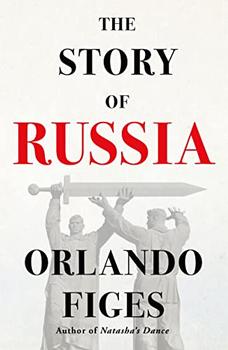Summary | Excerpt | Reviews | Beyond the book | Read-Alikes | Genres & Themes | Author Bio

1613-1918
by Simon Sebag MontefioreThe Romanovs were the most successful dynasty of modern times, ruling a sixth of the world's surface for three centuries. How did one family turn a war-ruined principality into the world's greatest empire? And how did they lose it all?
This is the intimate story of twenty tsars and tsarinas, some touched by genius, some by madness, but all inspired by holy autocracy and imperial ambition. Simon Sebag Montefiore's gripping chronicle reveals their secret world of unlimited power and ruthless empire-building, overshadowed by palace conspiracy, family rivalries, sexual decadence and wild extravagance, with a global cast of adventurers, courtesans, revolutionaries and poets, from Ivan the Terrible to Tolstoy and Pushkin, to Bismarck, Lincoln, Queen Victoria and Lenin.
To rule Russia was both imperial-sacred mission and poisoned chalice: six of the last twelve tsars were murdered. Peter the Great tortured his own son to death while making Russia an empire, and dominated his court with a dining club notable for compulsory drunkenness, naked dwarfs and fancy dress. Catherine the Great overthrew her own husband (who was murdered soon afterward), enjoyed affairs with a series of young male favorites, conquered Ukraine and fascinated Europe. Paul I was strangled by courtiers backed by his own son, Alexander I, who in turn faced Napoleon's invasion and the burning of Moscow, then went on to take Paris. Alexander II liberated the serfs, survived five assassination attempts and wrote perhaps the most explicit love letters ever composed by a ruler. The Romanovs climaxes with a fresh, unforgettable portrayal of Nicholas II and Alexandra, the rise and murder of Rasputin, war and revolution - and the harrowing massacre of the entire family.
Dazzlingly entertaining and beautifully written from start to finish, The Romanovs brings these monarchs - male and female, great and flawed, their families and courts - blazingly to life. Drawing on new archival research, Montefiore delivers an enthralling epic of triumph and tragedy, love and murder, encompassing the seminal years 1812, 1914 and 1917, that is both a universal study of power and a portrait of empire that helps define Russia today.
The intrigue, scandal and violence that were part of everyday life for members of the imperial court make salacious reading. I'm somewhat amazed no one's yet made a mini-series about the dynasty; they were much more ruthless than the Tudors and the ruling family was in power for more generations than the Caesars (a family to which I was constantly comparing the Romanovs). Reading about the extensive political maneuvering and manipulation called to mind The Game of Thrones – on steroids. If it weren't so well documented one would think the tsars and their minions were products of a disturbed imagination...continued
Full Review
 (916 words)
(916 words)
(Reviewed by Kim Kovacs).
"Kremlin" is the Russian word for a castle or fortified complex, and many Eastern European cities, including Novgorod, Smolensk and Kiev have one. Most people however, associate the Kremlin with the seat of the Russian government in Moscow.
The site of the Moscow Kremlin, a hill near where the Neglina and Moskva Rivers converge, shows evidence of human occupation as early as 500 BCE and some speculate it was inhabited centuries before that. In 1147 Yuri Dolgorukiy, the Grand Duke of Kiev, built a wooden fort in this location; it became both the start of the city of Moscow and the precursor of today's Kremlin. The city grew in size and importance (in spite of being raided by the Mongols in 1208 and again in 1237) and eventually became the...

If you liked The Romanovs, try these:

by Orlando Figes
Published 2023
From "the great storyteller of Russian history" (Financial Times), a brilliant account of the national mythologies and imperial ideologies that have shaped Russia's past and politics - essential reading for understanding the country today.

by Bryn Turnbull
Published 2022
This sweeping novel takes readers behind palace walls to see the end of Imperial Russia through the eyes of Olga Nikolaevna Romanov, the first daughter of the last tsar.